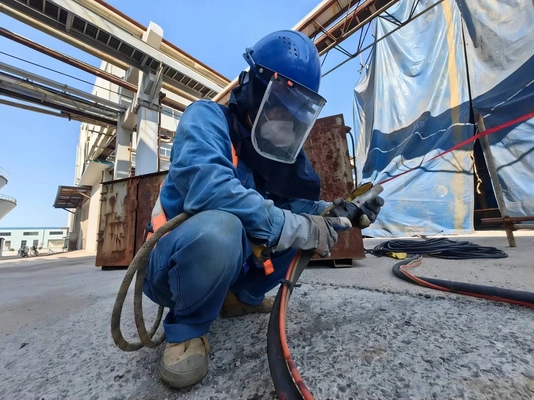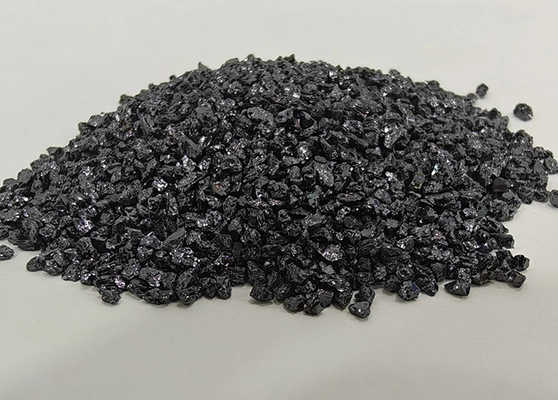
Abrasive blasting is a versatile surface preparation technique widely used in industrial applications to clean, smooth, or etch materials. This process involves propelling abrasive materials at high speeds against a surface to remove contaminants, rust, or old coatings. In the B2B sector, especially for foreign trade websites, understanding abrasive blasting can help businesses optimize manufacturing processes and enhance product quality. It's a cornerstone of industries like automotive, aerospace, and construction, making it essential for global trade professionals.
The Definition and Basics of Abrasive Blasting
Abrasive blasting, often referred to as sandblasting, is a method that uses high-pressure air or water to direct abrasive particles onto a substrate. The primary goal is to alter the surface by removing impurities or creating a specific texture. This technique is crucial in foreign trade for preparing products for export, ensuring they meet international standards for durability and appearance.
At its core, the process requires three main components: an abrasive material, a blasting machine, and a delivery system. Common abrasives include sand, glass beads, or steel grit, each chosen based on the material being treated. For B2B clients, selecting the right abrasive can reduce costs and improve efficiency in global supply chains.
Key Components Involved
The blasting machine is the heart of the operation, typically consisting of a pressure vessel, hoses, and a nozzle. These elements work together to accelerate abrasives to speeds that effectively strip surfaces. In international trade, companies often source these components from specialized manufacturers, highlighting the global nature of the abrasive blasting industry.
Safety equipment, such as protective gear and dust collection systems, is also vital to prevent hazards. This ensures compliance with regulations like those from the ISO, which is important for exporters dealing with multiple markets.
A Brief History of Abrasive Blasting
Abrasive blasting dates back to the late 19th century, with early uses in mining and metalworking. The invention of the sandblasting process in 1870 by Benjamin Chew Tilghman marked a significant milestone, allowing for more efficient surface cleaning than manual methods.
Over the decades, advancements like wet blasting and automated systems emerged, driven by industrial demands. In the context of foreign trade, this evolution has enabled businesses to export high-quality treated products worldwide, from the United States to Asia and Europe.
Today, the industry has grown into a multi-billion-dollar sector, with innovations focusing on eco-friendly abrasives. This historical progression underscores its role in modern B2B operations, where efficiency and sustainability are key selling points for international clients.
Types of Abrasive Blasting
There are several types of abrasive blasting, each tailored to specific applications. Dry blasting, for instance, uses compressed air to propel abrasives and is ideal for large-scale industrial projects. This method is popular in foreign trade for preparing ship hulls or machinery parts for export.
Wet blasting incorporates water to reduce dust and heat, making it suitable for delicate surfaces like automotive components. It's gaining traction in global markets due to its environmental benefits, helping companies comply with international environmental regulations.
- Dry Blasting: Fast and effective for heavy-duty tasks, commonly used in construction and manufacturing.
- Wet Blasting: Minimizes surface damage and dust, perfect for precision work in aerospace and electronics.
- Vapor Blasting: A variation of wet blasting that uses steam for a finer finish, often applied in automotive restoration for export-quality results.
- Centrifugal Blasting: Employs a wheel to hurl abrasives, ideal for high-volume production in B2B settings like metal fabrication factories.
Choosing the right type depends on factors like material type and project scale, which B2B professionals must consider when sourcing equipment from international suppliers.
Applications in Various Industries
Abrasive blasting plays a pivotal role in multiple sectors, particularly in manufacturing where it prepares surfaces for painting or coating. In the automotive industry, it's used to remove rust from vehicle parts, ensuring they meet global quality standards for export.
The construction sector relies on it for cleaning building facades and preparing concrete for bonding. For foreign trade websites, this application highlights opportunities for businesses exporting blasting services or equipment to emerging markets.
In aerospace, abrasive blasting is critical for deburring aircraft components, enhancing safety and performance. Similarly, in marine industries, it's essential for anti-fouling treatments on ships, supporting international shipping operations.
Specific Uses in B2B Contexts
For B2B clients, abrasive blasting facilitates custom fabrication, such as etching logos on metal products for branding. This is especially valuable in global trade, where customized goods can command higher prices in competitive markets.
Additionally, it's employed in the oil and gas industry to clean pipelines and equipment, preventing corrosion and extending asset life. These applications underscore its importance in maintaining supply chain integrity for international businesses.
Benefits and Advantages of Abrasive Blasting
One of the primary benefits is its efficiency in surface preparation, allowing for quicker turnaround times in production. This speed is a major advantage for B2B companies dealing with tight export deadlines.
It also enhances adhesion for coatings, reducing the risk of product failures and improving overall quality. In foreign trade, this leads to higher customer satisfaction and repeat business from global partners.
Cost-effectiveness is another key advantage, as it requires minimal equipment compared to alternatives like chemical stripping. For international traders, this means lower operational costs and better profit margins when scaling operations.
- Versatility: Works on various materials, from metals to plastics, making it adaptable for diverse B2B needs.
- Durability: Treated surfaces resist wear, extending product lifespan and reducing maintenance for exported goods.
- Customization: Allows for precise control over surface finishes, catering to specific client requirements in global markets.
Safety Considerations in Abrasive Blasting
Safety is paramount in abrasive blasting due to risks like dust inhalation and high noise levels. Operators must use protective equipment, such as respirators and earplugs, to mitigate health hazards.
Proper ventilation and containment systems are essential to control airborne particles, ensuring compliance with OSHA and EU safety standards. For B2B exporters, adhering to these regulations is crucial for accessing international markets.
Training programs for workers can prevent accidents and improve efficiency. In foreign trade, emphasizing safety in marketing materials can build trust with global clients concerned about ethical practices.
Environmental Impact of Abrasive Blasting
While effective, abrasive blasting can generate waste and pollution if not managed properly. Traditional methods using silica sand may release harmful dust, prompting a shift to greener alternatives like recycled glass beads.
Modern systems incorporate recycling mechanisms to minimize waste, aligning with global sustainability goals. For B2B websites, highlighting eco-friendly options can attract environmentally conscious buyers in Europe and North America.
Regulations such as the EPA's guidelines encourage the use of water-based blasting to reduce emissions. This not only protects the environment but also opens doors for trade with regions prioritizing green technologies.
Frequently Asked Questions
Below are some common questions about abrasive blasting, answered to provide clarity for B2B professionals.
- What materials can be blasted? Abrasive blasting works on metals, concrete, wood, and plastics, making it versatile for various industrial applications in global trade.
- How does it differ from other cleaning methods? Unlike chemical cleaning, it uses mechanical force for thorough removal without residues, ideal for export preparation.
- Is abrasive blasting expensive? Initial setup costs are moderate, and it's cost-effective for large-scale operations, offering good ROI for international businesses.
- What safety precautions are necessary? Always use PPE and ensure proper ventilation to avoid health risks, as required by international safety standards.
- Can it be used on delicate surfaces? Yes, with techniques like wet blasting, which is gentler and suitable for precision work in sectors like electronics.
- How does it impact the environment? When done responsibly, it minimizes waste through recycling, supporting sustainable practices in global supply chains.
In conclusion, abrasive blasting is an indispensable process in the industrial world, offering efficient surface treatment solutions that drive B2B success in foreign trade. By understanding its definitions, types, applications, and best practices, businesses can leverage this technique to enhance product quality, ensure safety, and meet global demands. Whether you're a manufacturer or trader, integrating abrasive blasting into your operations can lead to improved efficiency and competitive advantages in the international market.
Request a Quote or Sample
Popular Products
Grünes Siliziumkarbid
View DetailsSchwarzes Siliziumkarbid
View Details